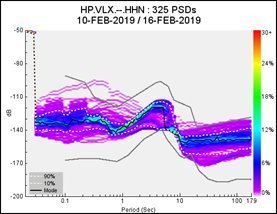National Western Greece Seismic Network
1. Introduction
GEObit instruments won recently, (Bid tender, July 2018), the contract for the supply of digitizers to the Seismological Laboratory of the University of Patras (UPSL) [2]. The UPSL replaces old or damaged seismic digitizers with new, state of the art units, integrated with onboard seedlink servers, according to the national regulations of seismic station requirements. Six (6) GEObit SRi32S[1] data-loggers are going to get connected with already existing broadband seismometers.
2. Seismic Network
The National Western Greece Seismic network is part of the Hellenic Unified Seismic Network [3](HUSN) located in western Greece. It consists of 22 stations (July 2018), some of them in operation and some others, not. During the first phase of the upgrade / replacement, three stations (AXS, VVK, VLX) were equipped with GEObit data-loggers. The seismometer is an NMX Trillium40T.
Figure 1
The
Figure 2: The
3. Installations
The GEObit data-loggers replaced NMX Janus at stations AXS and VLX. The old VLX station was equipped by an old GEObit SR24 digitizer and an S100 sensor, being in operation since 2006, and it was decided to be upgraded as a broad-band station using another NMX Trilluium40T which was in stock at UPSL.
3.1. The AXS station
This station was re-installed in September 2018. The station used to get power from the electricity network but because of the problems caused, it was decided to switch to solar power in order to isolate it from the local problematic electricity network. The data are transmitted in real-time over seedlink using GSM/3G network.
Figure 3: The AXS station and GEObit SRI32S data-logger
Figure 4: The AXS station and GEObit SRI32S data-logger
3.2. The VVK station
This station was re-installed in October 2018. The data are transmitted in real-time over seedlink using GSM/3G network.
Figure 5 & 6: The VVK station and GEObit SRI32S data-logger
3.3. The VLX station
Figure 7 & 8: The VLX station and GEObit SRI32S data-logger
4. Performance
All three stations are performing extremely well in terms of signal quality, stability and data transmission. The data are acquired by the UPSL from Seiscomp3 software and shared to an Earthworm sever as well. They are also shared to the HUSN over seedlink protocol.
The PSD of the signal is calculated at National Geodynamics Institute of Greece[3]. The heliplots are produced by UPSL Earthworm [2].
4.1. AXS station Signal and PSD
Figure 9: Typical AXS Z channel helicorder plot
Figure 10: Typical AXS Y channel helicorder plot
Figure 11: Typical AXS X channel helicorder plot

Figure 12: Typical AXS Z channel PSD plot

Figure 13: Typical AXS Y channel PSD plot

Figure 14: Typical AXS X channel PSD plot
4.2. VVK station Signal and PSD
Figure 15: Typical VVK Z channel helicorder plot
Figure 16: Typical VVK Y channel helicorder plot
Figure 17: Typical VVK X channel helicorder plot

Figure 18: Typical VVK Z channel PSD plot

Figure 19: Typical VVK Y channel PSD plot

Figure 20: Typical VVK X channel PSD plot
4.3. VLX station Signal and PSD
Figure 21: Typical VLX Z channel helicorder plot
Figure 22: Typical VLX Y channel helicorder plot
Figure 23: Typical VLX X channel helicorder plot

Figure 24: Typical VLX Z channel PSD plot

Figure 25: Typical VLX Y channel PSD plot

Figure 26: Typical VLX X channel PSD plot















